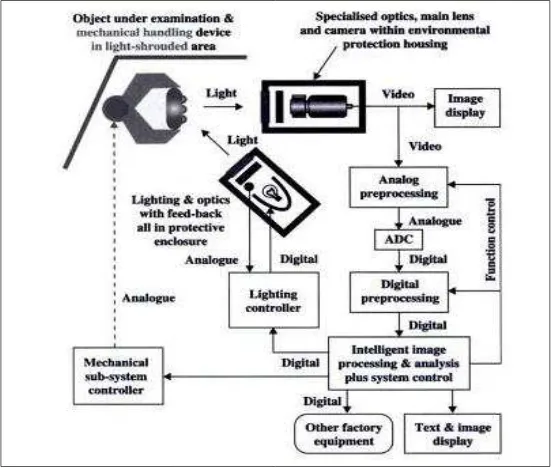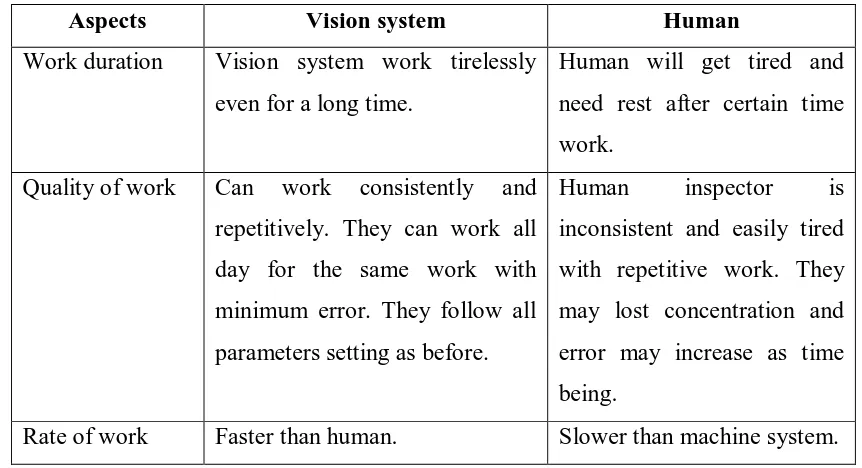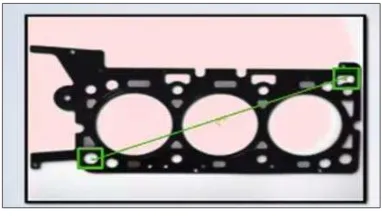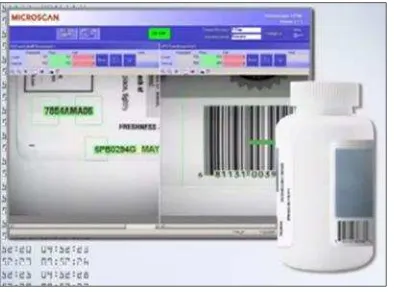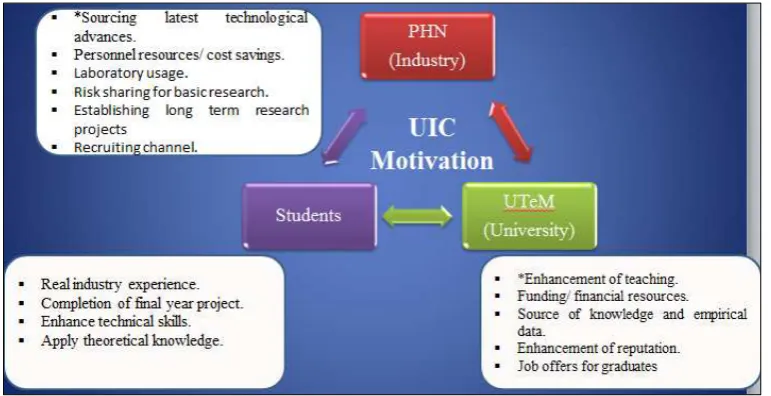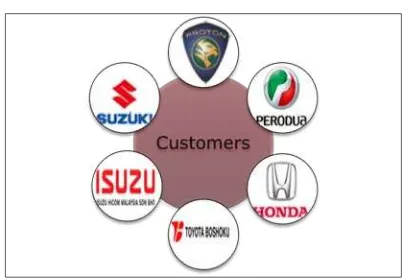DEVELOPMENT OF VISION INSPECTION SYSTEM
FOR AUTOMOTIVE ASSEMBLED PART
RADIN PUTERI HAZIMAH BINTI RADIN MONAWIR
B050910192
UNIVERSITI TEKNIKAL MALAYSIA MELAKA
DEVELOPMENT OF VISION INSPECTION SYSTEM FOR
AUTOMOTIVE ASSEMBLED PART
This report submitted in accordance with requirement of Universiti Teknikal Malaysia Melaka (UTeM) for the Bachelor Degree of Manufacturing Engineering
(Robotics and Automation) (Hons.)
by
RADIN PUTERI HAZIMAH BINTI RADIN MONAWIR
B050910192
900507-08-6506
UNIVERSITI TEKNIKAL MALAYSIA MELAKA
BORANG PENGESAHAN STATUS LAPORAN PROJEK SARJANA MUDA
TAJUK: DEVELOPMENT OF VISION INSPECTION SYSTEM FOR AUTOMOTIVE
ASSEMBLED PART
SESI PENGAJIAN: 2012/13 Semester 2
Saya RADIN PUTERI HAZIMAH BINTI RADIN MONAWIR
mengaku membenarkan Laporan PSM ini disimpan di Perpustakaan Universiti Teknikal Malaysia Melaka (UTeM) dengan syarat-syarat kegunaan seperti berikut:
1. Laporan PSM adalah hak milik Universiti Teknikal Malaysia Melaka dan penulis. 2. Perpustakaan Universiti Teknikal Malaysia Melaka dibenarkan membuat salinan untuk
SULIT
i
DECLARATION
I hereby, declared this report” Development Vision Inspection System for Automotive Assembled Part” is the results of my own research except as cited in references.
Signature : ………..
Author’s Name : RADIN PUTERI HAZIMAH BINTI
RADIN MONAWIR
Date : 03/06/2013
ii
APPROVAL
This report is submitted to the Faculty of Manufacturing Engineering of UTeM as a partial fulfillment of the requirements for the degree of Bachelor of Manufacturing Engineering (Robotics and Automation) (Hons.). The member of the supervisory committee is as follow:
..………..
iii
DEDICATION
iv
ACKNOWLEDGEMENT
v
ABSTRAK
vi
ABSTRACT
viii
2.4.2C++ Language 27
2.4.3 LabVIEW 27
CHAPTER 3 :METHODOLOGY
3.1 Project Concept 29
3.2 Hardware and Software for Image Capturing 31
3.2.1 Software and Hardware Specifications 32
3.6 Environmental, Experimental and Sample Set Up 47
ix A Samsung Galaxy Ace S5831 Specifications B Bluetooth specifications
C Bluetooth vs WiFi D Yue Wu's Coding
E Part1 Algorithms for Correlation Matching F Part2 Algorithms for Correlation Matching G Algorithms for SSDXCO
x
LIST OF TABLES
1.1 Comparison vision system and human. 3
2.1 Summarization of image capturing hardware. 13
2.2 Image processing methods 14
2.3 Comparing method of inspection. 25
3.1 Specification of android application 32
3.2 Sample images of side 1 and 2 without cropped. 49 3.3 Side 1 and side 2 sample images that have been cropped. 50 3.4 Rotation of side 1 and side 2 at 10o -40o. . 52 3.5 Rotation of side 1 and side 2 at 45 o ,90-o , 135o and 180o. 52
3.6 Randomly modified image sample. 54
4.1 Range of template matching when template from input at different 59
4.2 Results for Sid 1 and side 2 . 61
4.8 Summarized results of rotated images (SSDXCORR) 66 4.9 Results when decreasing brightness of sample images. 66 4.10 Results when increasing brightness of sample images. 68 4.11 Summarized results of Table 4.7 and Table 4.8 (CC). 68 4.12 Brightness adjustment result by using SSDXCORR 69
4.13 Accuracy test 1 70
4.14 Result of repeating test 1 in Table 4.10 71
4.15 SSDXCORR results on random sampling 72
4.16 Summarized results of accuracy testing 72
xi
LIST OF FIGURES
1.1 Comparison vision system and human. 3
2.1 Summarization of image capturing hardware. 13
.2.2 Image processing methods 14
2.3 Comparing method of inspection. 25
3.1 Specification of android application 32
3.2 Sample images of side 1 and 2 without cropped. 49 3.3 Side 1 and side 2 sample images that have been cropped. 50 3.4 Rotation of side 1 and side 2 at 10o -40o. . 52 3.5 Rotation of side 1 and side 2 at 45 o ,90-o , 135o and 180o. 52
3.6 Randomly modified image sample. 54
4.1 Range of template matching when template from input at different 59
4.2 Results for Sid 1 and side 2 . 61
4.8 Summarized results of rotated images (SSDXCORR) 66 4.9 Results when decreasing brightness of sample images. 66 4.10 Results when increasing brightness of sample images. 68 4.11 Summarized results of Table 4.7 and Table 4.8 (CC). 68 4.12 Brightness adjustment result by using SSDXCORR 69
4.13 Accuracy test 1 70
4.14 Result of repeating test 1 in Table 4.10 71
4.15 SSDXCORR results on random sampling 72
4.16 Summarized results of accuracy testing 72
1
CHAPTER 1
INTRODUCTION
The development of Vision Inspection System for Automotive Assembled Part is a university-industry collaboration (UIC) project between PHN Industry Sdn. Bhd and UTeM. In this project, a vision inspection system for assembled automotive part has been developed. This project focused on image processing, developing algorithm and programming for vision system using MATLAB. Sample for this research is a car door. This system inspected the assembled metal part by firstly capturing the image, processing the image and comparing the image with template images data before executing result; whether current part is accepted or rejected.
1.1Project Background
1.1.1 Vision Inspection System
2
Figure 1.1: Archetypal machine vision system. (Gr aves & Batch elor , 2003) .
1.1.2 Advantages using vision inspection system
3
Figure 1.2 : Exampled of mislabelled product (Microscan System Inc., 2012).
On top of that, vision inspection system also enabled company to have better yield; ability to turn input product to saleable end product. The soon the defects are eliminated , especially from entering next stage, the more the material can be saved from being scrap or need to rework. Moreover, vision inspection system may also keep the defected and good products record after being inspected. Company may have as many records as they want relevant to their storage memory. Therefore, if any defected products miss into next stage or line, it still can be track and trace based on storage memory.
Machine vision also has many advantages as compared to human inspectors. This can be explained through comparison in Table 1.1 below:
Table 1.1: Comparison vision system and human.
Aspects Vision system Human
Work duration Vision system work tirelessly even for a long time.
4 1.1.3 Applications of Vision Inspection System
According to (Graves & Batchelor, 2003)and Steger, Ulrich and Wiederman (2008) vision system provided imaging-based automatic inspection and analysis for applications such as automatic inspection, process control, and robot guidance in industry. Vision system is increasingly used with robot automation to perform various task; part identification, inspection, location, orientation, and range finding (A.Rehg, 2000).
Part identification is an example of vision system application that has been commercialized now. The image that has been captured is stored in memory and later will be used as data to distinguish part as they enter the work cell. From this storage data, system learns the characteristic of different parts and identifies each part from its two-dimensional silhouette. This feature can stand-alone, act as sorting purpose or air with inspection ability, where system recognise object and count the number of object. For example, in beverages packaging, the system will recognise the bottle and inspect whether the number of bottles inside a box is correct (refer to Figure 1.3).
Figure 1.3: Counting application of vision system, (Microscan System Inc., 2012).
5
Figure 1.4: Vision system inspect spanar dimension. (Micr oscan System In c., 2012) .
Figure 1.5: Number of holes is counted by using vision system
(Micr oscan System In c., 2012) .
Vision system also allow user to locate randomly placed parts on X-Y grid in. It measures X and Y distances from the centre part of camera coordinate system to the centre of the randomly placed part(Figure 1.6). This method also can be used to know part orientation by applying certain extra mathematical formulas.
6
In the meanwhile, range finding is used to measure and calculate cross-sectional of parts. Other than above application, vision system also able to decode. This can be done by capturing and processing the bar code (Figure 1.7).
Figure 1.7: Decoding application by using vision system (Microscan System Inc, 2012).
Note that, beside integrated with robot, machine vision also can be integrated with PLC or stand-alone too (A.Rehg, 2000).
1.1.4 UIC Collaboration
Development Vision Inspection System for Automotive Assembled Part is university-industry collaboration (UIC) project between PHN Industry Sdn. Bhd. University-Industry Collaboration (UIC) is a strategic cooperation which provided win-win results between university and industry.
7
Figure 1.8: UIC Concept.
The collaboration between UTeM and PHN opens numerous opportunities. The development of the system benefits the UTeM in term of knowledge gain, industry exposure, professional acknowledgement (i.e. IR/PE) and portfolio proliferation. Meanwhile, PHN gains advantages in good return of investment (ROI) by producing higher number of quality products yet less investment cost.
*
8 1.1.5 Company Profile
PHN Industry Sdn. Bhd., abbreviated from Proton-Hicom-Nagoya is a Malaysian automotive manufacturer components founded in 1990. PHN is headquartered in Shah Alam, Selangor, Malaysia. It also owns four other plants in BB, USJ, Pekan and Melaka. It is a part of DRB Hicom group.
There are three main activities; stamping, assembly and die manufacturing. Stamping is normally done by using dies that are provided by customer to shape the sheet metal. For assembly, normally, the part that has been welded has been stamped in the PHN itself or from outsourcing. Meanwhile, in die manufacturing, PHN manufacture dies to be used internally and imported to external market.
Figure 1.10: Main PHN Industry Customers.
1.2 Problem statement
